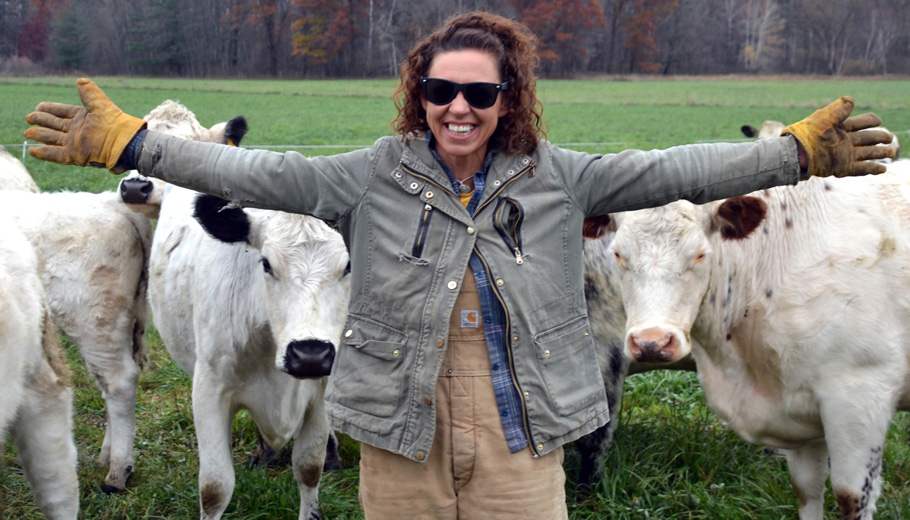
Getting local grass-fed beef on the menu
By James Card
Rachel Bouressa loves cheeseburgers and one of her biggest goals is getting burgers from her family farm into local restaurants and bars.
She believes that people would love the option to order burgers made with grass-fed beef.
“I think that customers in our area would pay extra to have that option. There are some restaurants that do a good job. I’ve worked with Green Fountain quite a bit with steaks. I do have restaurants that want steaks from me but I cannot supply enough steaks. The problem with beef producers trying to get into restaurants is the steak count. You only get so many steaks per animal. It’s hard to meet their demand – at least at my scale – to be a consistent supplier,” she said.
Ground beef is much easier for the beef producer to maintain a consistent inventory.
“It’s more accessible as an entry point for any restaurant. It doesn’t take anything fancy to make a grass-fed cheese burger taste good,” said Bouressa.
Her family moved to this farm when she was in the first grade. When she was in middle school her parents transitioned into managed grazing during the dairy crisis in the 1990s.
“It was the only economically viable way to stay as dairy farmers without having to quit,” she said.
She went to her first grazing conferences as a middle school student. Bouressa studied in the agronomy and soil program at the University of Wisconsin-Madison and went into a master’s program in agro-ecology.
Meanwhile the family’s dairy barn burned down while almost everybody was across the Pacific Ocean. Her parents were in Australia, one brother was in Hawaii, another in Japan.
“I get to joke that I live in the most exotic place of all – here in central Wisconsin,” she said.
She never thought she would go into farming despite her background and being in the FFA in Weyauwega. While working on the agro-ecology coursework, she was learning more about the benefit of grass-fed beef.
In a class about rural sociology, she learned there were three barriers for entry into agriculture: “Access to land. Access to capital. And education. Well, I have all three of those. I should take advantage of that and go farm,” she said.
While the rest of the family was away, they rented the fields to Quantum Dairy. After 14 years in Madison, Bouressa moved back to the 360-acre family farm and started with 15 unrented acres and 13 Angus steers. Now her herd grazes in 80 acres of pasture and is up to 70 head. They are British White Park cattle, a breed well suited for grass.
“They are a really docile and hardy breed,” she said. Next year, 28 calves will be born and each one gets a name with the same letter. This year was K, next year is L.
She drove her Kawaksaki side-by-side on a two-track out to a far corner of the farm. She looked for Dora, her favorite cow and one so friendly Bouressa thinks she might be able to ride her. Dora is the cow people pet when she gives tours of the farm. She hosted children from Sunny Day Child Care Center on the farm and this fall she threw a Bluegrass and Burgers party for friends and neighbors.
“This is my favorite place on the farm. I call this the ‘gateway to the new land,’” said Bouressa. She said it’s a place where birds migrate through every year and eagles, cranes and turkeys abound. “Prior to me taking this over, it was continuous corn, silage and liquid manure. Even though this is my family’s land, they planted the corn up to the tree line, and they tilled heavily in the fall and we could hardly come up here. It’s extra special for me to see the trees and the land,’ she said.
Bouressa designs grazing plans for other farmers. This was the first time the document read: “Plan written for Rachel Bouressa. Plan written by Rachel Bouressa.” She laid it out so that anyone can drive out without passing through fences. She put in lanes where she can move the cattle from any field to other fields by opening gates. There is a mile of water lines she put in herself.
Most of her beef goes to individual customers and is sold in quarters and halves. She has a long waiting list. But she also understands not everyone can buy a half or quarter cow at a time so she offers retail packages of meat in smaller amounts. These can be ordered via her website (bouressafamilyfarm.com) and Bouressa coordinates delivery. She is working on a creating farm store retail space for visitors.
She also recently offered what she calls the Power Blend, a burger mix of ground beef, liver and heart. The idea is to slip in the healthy nutrient-dense organ meats that some people find hard to swallow, into much more palatable meatballs or cheeseburgers.
